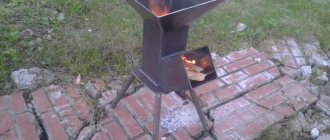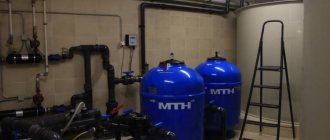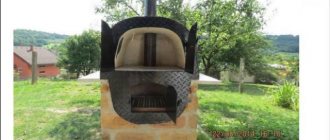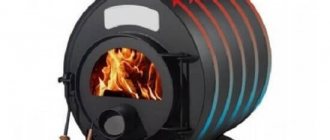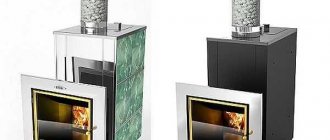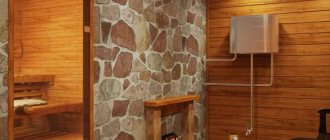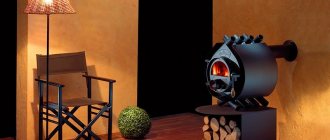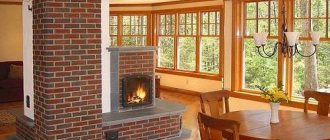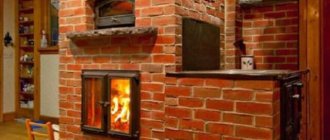For heating such premises as a temporary shed, change house, basement, utility room, workshop, etc. Usually you want to save as much as possible.
People may not be here all the time, the interior is very simple, and there may simply be no electricity.
There are many options, let’s consider the miracle of a diesel fuel stove (or “solar gas”, as it is also called) - a simple, effective and inexpensive, in all respects, heating method.
Principle of operation
Liquid fuel (this can be not only diesel, but also kerosene) enters an annular tank with fuel, where a fiberglass wick is rolled up.
The wick is soaked and burns, with a burner placed above it.
The gaseous mixture enters the combustion chamber (a system of cylinders with a large number of jumpers, holes, etc.), where it burns out layer by layer and evenly.
The design of the cylinders in the combustion chamber allows the use of convection and infrared heating mode. These stainless elements heat up to 800 °C and heat the air, infrared rays (length 620 -700 nm) are reflected from the mirror screen and directed into the room, and heat objects.
Combustion in this device takes place practically without open flame. You can determine whether the process is going correctly by eye.
The flame should not rise above the protective grill (both the grill itself and the wick can burn).
Classification of species
Kerosene heaters are divided into devices with installed electronics, as well as without it. Electrical devices have a large number of useful functions that the owner can use. These include:
- Automatically turns off and turns on the device.
- Safety system.
- Built-in fan. This component increases noise during operation, but at the same time increases the rate of heat propagation.
With the help of automation, the temperature will be maintained at the same level. But autonomous heating systems, which do not need to be connected to electricity, are used even far from civilization - this is their significant advantage. The downside is that this type of equipment is less safe, since no protective functions are provided.
You can also find a device on sale that runs exclusively on kerosene.
Diesel-kerosene models are also available.
Diesel stoves
pros
- Provides independence from the supply of central heat sources (gas, electricity).
- Available fuel.
- Compactness.
- Ability to adjust intensity.
- The unit itself is cheap (only 2 - 3 thousand rubles).
- The surface is designed so that you can place a container of food or tea and heat it up (but not cook!).
- No open flame, no chimney required.
An undeniable advantage is the mobility of the furnace. It can be easily transported from room to room (the weight of the device is less than 6 kg, there is a handle), taken on a trip, to the dacha, fishing, to dry the cellar with it, etc.
With low fuel consumption (about 200 - 400 grams per hour), the power of the device is very serious - 1.8 - 5 kW.
If you consider that you can fill the tank with 2–2.5 liters of fuel at a time, then the operating time on one fill will be 5–12 hours, depending on consumption.
Minuses
- Not suitable for residential premises as a permanent heating device due to the unpleasant odor and smoke entering the room.
- The need to replace wicks (every few months, or every 5 - 7 tanks of fuel).
- The need for periodic cleaning of the burner.
About diesel heat guns
Heating units of this type are designed to heat large areas (from 30 m²) in all weather conditions. A diesel stove is a warm air blower in the form of a pipe mounted on wheels for ease of movement. A turbine built at the end of this pipe is responsible for creating the air flow. The burner for the stove, which burns diesel fuel, is placed inside the combustion chamber and is washed with air from all sides. There are 2 types of heat guns:
- Directly heated. This means that the air passing through the pipe is heated by the walls of the chamber and mixed with the combustion products coming out from there, and then the mixture of gases enters the room. The heater is very efficient, but is not suitable for use in confined spaces.
- With indirect heating. The design is similar to the first, but the exhaust gases are not mixed with the air flow and are directed through a separate channel into the chimney, as shown in the diagram. The heater loses efficiency, since part of the heat is lost along with combustion products, but it is absolutely safe and is capable of heating living spaces.
Diagram of operation of a diesel gun with direct heating of the air flow
Note. Due to their design, heat guns are dependent on the supply of electricity. Without it, the fan and automatic heater will not turn on.
Let us list the main advantages of diesel-fired air stoves:
- the ability to heat large areas, for which models with a power of 10 to 100 kW are produced;
- acceptable diesel consumption;
- mobility;
- maintaining the required air temperature in the room;
- automatic safety system that turns off the pump and fuel supply to the nozzle in case of overheating, power outage and other emergency situations;
- high speed of heating the entire volume of the room.
Operating principle of a diesel fuel air heater with a chimney
An example regarding fuel consumption. The well-known manufacturer of climate control equipment Ballu claims the following indicators: a 20 kW unit consumes 1.6 kg/h of diesel fuel (about 2 l), 30 kW – 2.4 kg/h (up to 3 l), and a 50 kW heater “eats” 4 kg/h diesel fuel (up to 5 l).
The main disadvantage of powerful diesel heaters is their high cost. Take products from the same brand Ballu, which is included in the middle price category: a direct heating installation with a power of 10 kW will cost 270 USD. e., and indirect at 20 kW - as much as 590 cu. e.
Diesel stove with forced air - inside view
The second important disadvantage relates to direct heating units that emit flue gases along with the air. This feature greatly limits the scope of application of air heaters of this type. It is possible to safely use a heat gun only in industrial or technical premises with forced ventilation or at construction sites for local heating.
Advice. There is a way to reduce the cost of installing a diesel heat gun in your country house or garage. You need to get a small-sized diesel fuel stove, used in trucks, and modify it a little. A unit from the Webasto brand will be suitable (it’s better to look for it at a disassembly site, a new one is very expensive) or the Soviet analogue OV-65.
Miracle oven design
Solar gas is a small rectangular body, in the rear of which there is a fuel tank and a removable “wick bowl” tank in the center. These two containers are connected according to the principle of communicating vessels. A valve is installed on the outlet pipe that regulates the fuel supply. A wick-burner on a cylindrical base is immersed in the tank (the same principle was used in kerosene lamps).
An adjusting screw is installed on the burner, with which control is carried out. Behind the burner is a reflector.
Miracle diesel stove - design
Device
This oven consists of elements:
- Removable fuel mixture container. The container has a valve.
- Wick and part of the block.
- Frame.
- Burner.
- Screw for adjustment.
- Lattice.
- Reflector.
A reflector made of metal material is mounted on a body that is painted with a powder-type paint. Due to this element, the house is heated most well.
The burner itself is installed in the central part of the device, and diesel fuel is supplied independently from the fuel tank, which is installed on the rear panel. The adjustment screw is necessary to set the appropriate temperature when heating the house. All stoves are made of material that is resistant to high temperatures.
Ignition
It is better to ignite outdoors, and only then bring the working device into the house (this will avoid unpleasant odors in the room).
If the stove has not been used for a long time, it must be cleaned before starting ignition. The grate, burner, tank on the rear wall are removed, and the entire fuel unit is pulled out. All parts are cleaned, the reflector screen is rubbed.
It is very important to install the device strictly horizontally, otherwise it will be difficult to achieve uniform burning of the wick along its entire length.
Then ignition:
- Fuel is poured into the removable tank.
- A new wick is installed in the burner (twisted into a ring at the bottom of the burner).
- The burner and grate return to their original place.
- The valve unscrews slightly, which allows fuel to access the wick.
- The front panel opens and acts as a door.
- The edge of the rolled paper is lit and brought to the burner from below.
- When the fuel burns well and the flame rises above the grate, the valve closes completely (the red-hot bottom of the burner will indicate that sufficient heating has occurred).
- After waiting until the flame begins to go out, turn it off again, but this time to the intensity that you would like to achieve.
When you need to turn off the stove, turn the valve all the way.
While the user has little experience in handling the stove, it is very difficult to achieve even burning of the wick (this can take more than half an hour).
But if you have experience igniting, but still cannot get a blue flame throughout the entire wick, this may be one of the following problems:
- Uneven surface, tilt of the oven.
- The burner cylinder has not yet warmed up completely.
- The wick is worn out (it burns slightly every time and the more it is used, the more damaged it becomes).
You can try to extend the life of a worn wick by simply turning it over, or trimming the burnt edge with scissors. To make the wick last longer, it can be periodically washed in kerosene.
Distinctive features
A stove assembled by yourself has a number of advantages:
- it saves fuel;
- if desired, you can design a stove of any size, which will be the most suitable option for a given room;
- easy to transport;
- ease of use;
- The oven dripper can be used for cooking. To do this, when constructing a stove, the pipe is placed on the side.
Diagram of a diesel-powered dropper stove. This is a very economical design. Complete combustion of compounds occurs in the furnace chamber
This is important to know: during the combustion of fuel, an unpleasant odor may form, so the room must be well ventilated. When making a drip stove with your own hands, you need to follow fire safety precautions:
When making a drip stove with your own hands, you need to follow fire safety precautions:
- the device must be located in a draft-free room;
- flammable objects should be absent near the stove; it is advisable to have free space next to it (about half a meter);
- Do not use water to extinguish or cool the stove.
Materials needed to build the furnace:
- sheet metal;
- copper pipe;
- pipe branch;
- rubber hose;
- gas cylinder;
- screws;
- medical burner.
A popular do-it-yourself device is a drip stove made from a gas cylinder
- Before lighting a diesel stove, you need to install the tank in the right place and fill it with fuel.
- The next step is to remove the burner grate and install the wick into the block.
- After this, the burner and grate are reinstalled, the adjusting screw is opened and after 30 seconds the burner can be ignited.
- After intense combustion begins, you will need to tighten the adjusting screw all the way and wait a little for the flame to settle.
- Then open it back, setting the desired degree of heating.
- The device is turned off by screwing in the screw until it stops. In this case, you need to make sure that the diesel fuel burns out completely and the fire goes out completely.
In order for a diesel fuel stove to bring exceptional benefits to the owner, it is necessary to adhere to certain safety rules during operation.
- Do not use the device in a poorly ventilated area.
- Do not install the device in close proximity to furniture or other flammable objects.
- It is prohibited to use other fuel that is not specified in the passport data.
- It is prohibited to keep flammable substances near a working structure.
In addition, care should be taken to ensure that the oven is protected from water.
The length of the chimney should exceed four meters - this will ensure rapid and effective removal of smoky gases. The number of horizontal sections in the chimney should be minimized to improve draft performance.
You need to light the stove as follows: place a piece of paper in the lower container, pour diesel fuel on top of it and set it on fire. After about ten minutes of burning, the fuel will begin to spontaneously ignite. Subsequently, fuel is regularly added to the tank as needed.
To increase the service life of the furnace, you should clean the structure from soot and combustion products accumulated there once every ten days.
Instructions for use:
- Initially, it is necessary to install the place in a place specially designed for it, after which diesel fuel is poured into it.
- The grate and burner are dismantled, which makes it possible to insert the wick into a special block.
- After installing the wick, the burner and grate return to their places.
- You need to make sure that all removable elements are securely fixed, after which you can open the adjusting screw.
- You need to wait about 30 seconds, this time will be enough to saturate the wick with diesel fuel.
- The burner is ignited.
- Wait until intense combustion begins; as soon as it occurs, the adjusting screw is tightened to the very end.
- You need to wait a little, and after the flame settles, open the adjusting screw again. Now you can adjust the degree of heating by setting the desired parameters.
- If it is necessary to stop the stove, you will need to tighten the adjusting screw all the way again.
- Before completing the work, it is imperative to make sure that there is no flame and that the diesel fuel has completely burned out. Fuel consumption depends primarily on the size and power of the unit; the figure can range from 140 to 400 ml per hour.
Precautionary measures
A heating device of this type cannot be used in bedrooms during rest periods, or in places where there is no or very poor ventilation! Diesel fuel emits acrid smoke, which can enter the room during ignition and extinguishing. The air exchange volume should be 20 m3 per hour or more.
At the same time, this should not be a drafty area.
Stove "Solyarogas"
Do not place the stove close to walls, furniture or other objects, especially if they are made of flammable materials. The distance around the device is at least 50 cm on each side.
Do not allow any liquids, including water, to come into contact with a burning stove.
It is not recommended to experiment with fuel. The manufacturer has already done this at the enterprise.
The results of such experiments can be read in the instructions, which list all brands of fuel compatible with this model.
Rating of the TOP 20 best mini-ovens 2021-2022
| TOP 4 best electric mini-ovens in price/quality ratio | ||
| 1 | Scarlett SC-EO93O18 | Find out the price |
| 2 | Gemlux GL-OR-1538LUX | Find out the price |
| 3 | REDMOND SkyOven 5706S | Find out the price |
| 4 | Gemlux GL-OR-1320MN | Find out the price |
| TOP 4 best mini convection ovens | ||
| 1 | Simfer M4558 | Find out the price |
| 2 | Kitfort KT-1703 | Find out the price |
| 3 | De'Longhi EO 12562 | Find out the price |
| 4 | HYUNDAI MIO-HY050 | Find out the price |
| TOP 4 best mini ovens with grill and convection | ||
| 1 | BBK OE5562MC | Find out the price |
| 2 | GALAXY GL2623 | Find out the price |
| 3 | Scarlett SC EO93O21 | Find out the price |
| 4 | Gemlux GL-OR-2265LUX | Find out the price |
| TOP 4 best mini-ovens with burners | ||
| 1 | Energy GН30 | Find out the price |
| 2 | GALAXY GL2618 | Find out the price |
| 3 | Energy GН25 | Find out the price |
| 4 | GEFEST PG 100 | Find out the price |
| TOP 4 best inexpensive mini-ovens | ||
| 1 | DELTA D-0123 | Find out the price |
| 2 | Great rivers Voronezh-1 | Find out the price |
| 3 | Kraft KF-MO 3801 | Find out the price |
| 4 | BBK OE-0912M | Find out the price |
DIY diesel oven
Making any heating device at home is a costly and time-consuming process. Calculations, metal cutting, welding and other operations are advisable only if their cost is significantly lower than the cost of factory analogues.
However, in the case of a miracle stove, which costs 2-3 thousand rubles, the costs are clearly not justified!
Homemade stove
But some improvements to the factory model of the miracle stove can be done with your own hands. Cheap solar gases have already been popularly nicknamed “Constructors”, from which you can complete an excellent liquid fuel stove!
"Chimney"
Solar gases are used in non-residential or well-ventilated areas. But if you need to heat a place where people sleep on a hike, they are not suitable, since they still smoke.
To install a miracle stove in a tent or minibus, craftsmen equip it with a homemade chimney. A funnel from a drainpipe is placed on the top part (upside down), and several pipe bends are connected to it and led out into a window or hole in the tent.
Convenient combustion adjustment
The rubber seal must be installed on the needle valve stem, where there is a technological groove near the thread.
Preventing kerosene evaporation
To do this, the receiving cup must be closed (this is exactly how kerosene gases have always been made). You will need a small metal plate 1 mm thick and three screws. A 20 mm hole is drilled in the plate in the place where the spring valve will pass. The plate is attached to the side with screws. A sealing rubber is installed between the valve and the cover.
A Russian stove is a complex design, and most often, if someone wants to build one in their home, people turn to stove makers. It’s possible to build a Russian stove with your own hands; you just need to understand the intricacies of stove construction.
See how stove heating with a water circuit works here.
Despite the development of technology, including in the field of construction, the principles of constructing stoves have remained the same and clay is used as a solution for the stove. Using this link https://microklimat.pro/otopitelnoe-oborudovanie/pechi/glina-dlya-kladki.html we will reveal all the secrets of mixing the correct clay solution and consider ways to test clay for fat content.
Review of models and manufacturers of electric frying pans
It is not difficult to purchase a miracle oven or an electric frying pan in household appliance stores. This inexpensive product can replace many household appliances, thereby saving space in the kitchen and money in your wallet. Having a miracle stove makes it much easier to please your loved ones with culinary masterpieces.
There are models with a smooth or grooved bottom. The former are ideal for stewing, baking and boiling, and the latter are good for frying and grilling. Often in devices there is a device that replaces a double boiler.
Round-shaped frying pans are the most popular, with square and elongated ones slightly behind.
When choosing a model, consider the power, because the more powerful the device, the faster the food will be cooked. The volume of the body and the height of the walls also matter.
Soviet-style miracle stoves
Now you can find three models of electric miracle stoves from the USSR era:
- standard – 2 l, 500 W;
- medium version – 3.5 l, 800 W;
- large version - 5 l, 1000 W.
Also interesting: Which pan is better for pancakes: rating, selection rules
Miracle stove traditional Soviet style
Modern analogues
Manufacturers equip modern models with additional functionality:
- The Remoska electric saucepan is considered a worthy analogue. This miracle stove is popular both in its homeland - the Czech Republic, and abroad. Recently the device was upgraded, it began to cope with its tasks even better. The product easily replaces a microwave, oven, stove, toaster, grill, steamer and multicooker.
- SMILE EFP-1190. The device allows you to cook food without a stove. The product has a non-stick coating. Glass lid with steam release hole. The frying pan also has a thermostat with a temperature regulator. Power – 1500 W.
- Clatronic PP-3411. In this grill pan you can not only cook, but also defrost food or reheat already prepared food. The product heats up quickly and retains heat for a long time. Thanks to the non-stick coating, you can cook without oil. The set includes a lid made of heat-resistant glass. Power – 1500 W.
- Sorceress-6. Square shaped device with ceramic coating. A steam bowl is included in the package. For convenient cooking, the device is equipped with a thermostat. Power – 1500 W.
- Sakura SA-7711GR. This is a great device and cooking with it is a pleasure. The products are ready quickly, nothing sticks. There are several operating modes. The product has a non-stick coating in the bowl. The sealed glass lid allows you to observe the cooking process. Power – 1500 W.
Remoska
SMILE EFP-1190
Clatronic PP-3411
Sorceress-6
Sakura SA-7711GR
Reviews
Consumers love miracle liquid fuel stoves. People find them practical and convenient. Used to heat garages, barns, and other household items. buildings
They note, however, that using a stove as a stove is not effective; cooking “is the same as using a radiator.” Food heats up much faster if you light a fire or use a burner with an open flame while camping. Another note is about the fuel supply control system.
Penza Solar Gases use a primitive, very inert method. In addition, the tap is not equipped with seals; air is sucked in, which leads to combustion instability. For example, Japanese liquid fuel stoves operating on the same principle are much better designed and easier to regulate.
One of the advantages is the rapid heating of the room, the smell during operation is practically not felt.
Application area
Installing a miracle stove using diesel fuel will be the optimal solution for heating greenhouses, country houses, basements, utility rooms, workshops, tents, garage buildings built in places where there is no possibility of connecting to centralized heat sources.
It can be used as a permanent or additional heating device, and you can also heat tea or other food on it. A kerosene stove is more suitable for heating country houses. Its efficiency is higher than that of diesel analogues, during operation no harmful substances are released into the atmosphere, and there is no unpleasant odor.
Other stove options for non-residential premises
Waste oil burners
They attract those who have access to this type of fuel. Although it is not so easy to make a burner, you need to use it with great care, but it gives its efficiency and does not lose popularity in its circles.
Long burning stoves
These are small stoves that allow you to create air heating.
They run on good quality solid fuel.
Special convection pipes on their sides draw in and warm the air, accelerating its circulation in the room.
Well-known models of this type: Buleryans, Brenerans, Butakovs, Termofor, Teplodar, Burzhuy-k, Besser.
So, whether a stove is good in comparison with other options can only be judged if you select two units for the same purpose.
For example, electric heaters can produce a third more power for the same cost, and some boilers can run on waste wood, which is much cheaper.
However, kerogen gas (and modern solar gases are those same kerogen gases) was not developed with the goal of reducing costs to a minimum, but as a portable and compact travel option. And I must say, it turned out to be a really convenient and safe stove.
Bubafonya is one of the variations of a long-burning stove. Making a Bubafonya stove does not require a lot of materials or time, so many craftsmen prefer to assemble the structure themselves rather than buy a ready-made version.
What is a muffle furnace and how to make it yourself, read on.
Heating with drippers
If a drip stove is used for heating, it needs a power of at least 15-16 kW. This cannot be achieved only by increasing the drop frequency: due to the increased heat generation, the drops will evaporate while still in the supply tube. The stove (now a homemade liquid fuel boiler) will start burning with pops and then go out. Therefore, in a heating boiler using diesel fuel and exhaust, the dropper tube is connected to a flame bowl in a jacket, cooled by an air flow.
But that is not all. Due to the same greater heat release, the evaporation of fuel and combustion of vapors will be more intense. Some of the fuel vapor will be immediately thrown aside, will not burn and will begin to accumulate in the volume of the boiler, which can lead to an explosion. Therefore, a swirler is installed at the outlet of the fuel line, and the design of the deflector will be different than in a drip stove.
The diagram for connecting a homemade diesel fuel drip boiler to the heating system is shown in the figure:
Diagram of a heating system with a diesel-powered drip boiler
Air supply at power up to approx. 12 kW thermoconvection energy-independent: the intake air is first heated in the air jacket of the chimney, and then cools somewhat in the aluminum corrugated hose, which provides the necessary “suction”. At higher power, a boost from the fan is required of approx. 60 W, for example, blowing the radiator of a VAZ-2109.
Note: drawings of a drip heating boiler made from a gas cylinder with a power of up to 12 kW and an air heating furnace made of pipes for 10 kW with a cooled drip are given on the following. rice.:
Drawings of diesel fuel drip boilers for water and air heating
A significant drawback of the described system is that in order to avoid burner extinguishing and the accumulation of explosive vapors in it, the water in the boiler jacket must flow countercurrent to natural thermosiphon circulation, i.e. top down. Therefore, the system requires a circulation pump with a non-volatile (thermomechanical) automatic emergency shutdown of the boiler in the event of a power failure. All this makes this system very complex and at the same time unreliable.
It is possible to build a drip boiler for a water heating system with natural thermosiphon circulation, but in this case its design becomes more complicated and it becomes necessary to force air into the cooling jacket of the fuel line. If you definitely want to heat yourself with diesel fuel or simply nothing else, then see the following for drawings of a drip heating boiler with natural circulation of coolant in the water jacket. rice.
Drawings of a diesel fuel drip boiler for a water heating system with thermosiphon circulation
